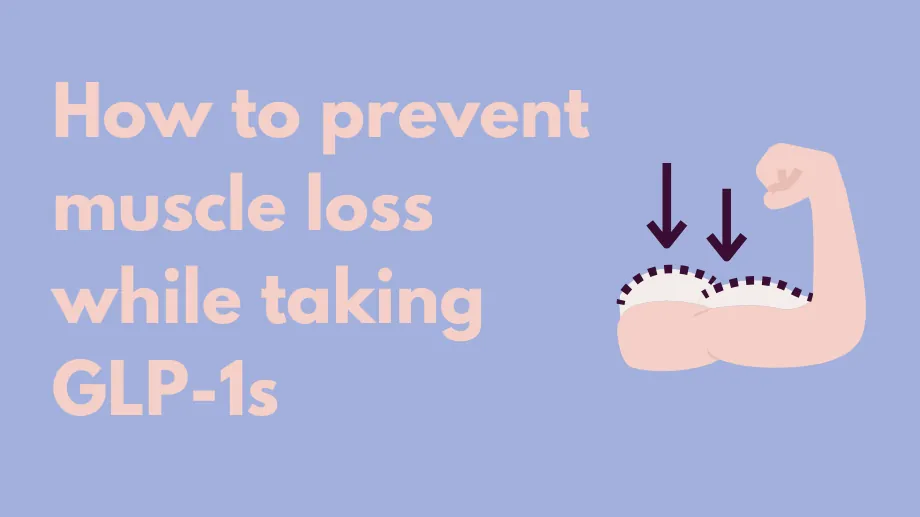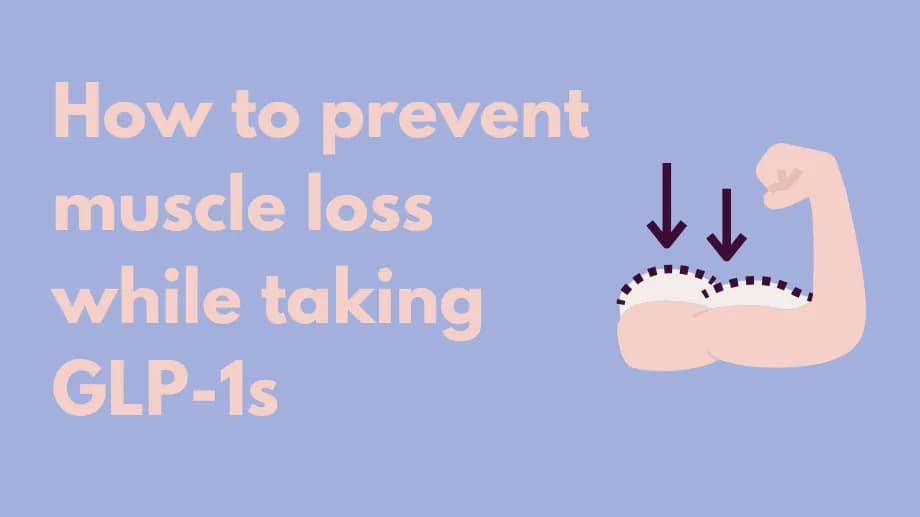How to prevent prevent muscle loss while taking GLP-1s?

The development of GLP-1 medications like Ozempic/Wegovy (semaglutide) and GIP/GLP-1 agonists like Mounjaro/Zepbound (tirzepatide) have been game changers when it comes to treating type 2 diabetes and obesity. While these medications can lead to significant weight loss, there are questions about how to combat side effects such as loss of muscle mass.
In this blog, we will discuss how rapid weight loss leads to a loss of muscle tissue and ways to prevent it.
How do GLP-1 drugs help you lose weight?
Glucagon-like peptide-1 (GLP-1) receptor agonists mimic (copy) the GLP-1 hormone that is naturally released in your gastrointestinal (GI) tract in response to food. Another role GLP-1 plays in the body: It slows down gastric emptying, so you feel more full, while also acting on specific brain receptors that promote satiety (a feeling of fullness).
When taken as prescribed with lifestyle changes such as a healthy diet and increased physical activity, and a nutrient-rich diet, GLP-1s can help:
- With weight management
- Lower your blood pressure
- Regulate your blood sugar levels
- Reduce your risk of heart disease
- With obstructive sleep apnea in obese people
Why does weight loss lead to a loss of muscle mass?
Researchers think that any type of rapid weight loss, including from weight loss drugs like GLP-1s, can lead to muscle loss in addition to fat loss. However, it is normal to lose some muscle mass whenever you lose weight. It is thought that around 25% to 33% of the total body weight lost is from lean muscle mass.
Studies suggest muscle loss with GLP-1 receptor agonists ranges from fat-free mass (FFM) decreases of 25% to 39% of the total weight lost over 36 to 72 weeks. This was compared to 10% to 30% FFM losses in people who had smaller amounts of weight loss from a low-calorie diet that did not take a weight loss drug. Additionally, the study found that the decrease in muscle mass with GLP-1s was several times greater than what is expected from age-related muscle loss.
But why does this happen? When you eat less food, your body converts fat and muscle into energy. While fat is targeted for the most part initially, it is not unusual for some of the needed energy to come from your muscle as well. The faster you lose weight, the more muscle gets broken down for energy. So, while you may look thin or be at a normal weight, you can have a body composition where you have a higher percentage of body fat relative to your muscle mass.
Why is muscle important?
Your muscles do much more than just help you move around and lift objects. They play an important part in maintaining your overall health and function, especially when you get older.
Besides helping with movement, muscles also help your body absorb sugar (glucose) when insulin is released after a meal. When you are overweight, you can become less sensitive to insulin. This can cause an increased breakdown of muscle protein and lead to muscle loss. Losing weight improves your insulin sensitivity, which, in turn, helps preserve muscle mass.
Strong muscles help support joint and bone health and maintain bone density, which can prevent issues like osteoporosis and bone fractures. This is especially helpful in older adults or women who have gone through menopause.
Muscle burns calories, even when you are sleeping. So, having more muscle mass can help you burn more calories and maintain a healthy weight.
These are just a few things your muscles help with on a day-to-day basis.
What can you do to preserve muscle mass while on GLP-1s?
GLP-1s should be taken along with a healthy diet and regular exercise. The current guidelines for adults are 150 minutes of moderate physical activity per week, with at least two days of strength training.
A well-rounded exercise program should include a combination of:
- Cardio: Depending on the type and intensity of your workout, this can burn from 200 to 600 calories per hour. Try walking, running, swimming, biking, dancing, or recreational sports.
- Strength training: You should have at least 2 days a week of resistance exercises to help increase your metabolism and build muscle mass. This can include body-weight exercises like squats and push-ups, resistance training with resistance bands, or weightlifting.
- Flexibility exercises: Stretching and activities like tai chi or yoga can help with your flexibility and range of motion, reduce your risk of injury, and improve your balance.
Please note that it is important to seek medical advice from your healthcare provider before starting any workout program.
In addition to increasing your physical activity, it is important to eat a healthy, balanced diet. Since GLP-1s decrease your appetite, it is important to eat nutrient-rich foods that contain vitamins, minerals, carbohydrates, and healthy fats. You may also benefit from supplements like multivitamins to help get all of the nutrients your body needs.
Your diet should also include enough protein intake to help support muscle preservation. Lean meats such as chicken and turkey, fish, eggs, quinoa, legumes, and nuts can be good sources of protein. You can also add protein shakes as a way to get more protein in your diet. Talk with your provider or a dietitian about a meal plan that is right for you.
Sources
- Neeland IJ, Linge J, Birkenfeld AL. Changes in lean body mass with glucagon-like peptide-1-based therapies and mitigation strategies. Diabetes Obes Metab. 2024 Sep;26 Suppl 4:16-27. Accessed Apr 2, 2025.
- Physical Activity Guidelines. Office of Disease Prevention and Health Promotion. Accessed Apr 2, 2025.
- Ida S, Kaneko R, Imataka K, et al. Effects of antidiabetic drugs on muscle mass in type 2 diabetes mellitus. Curr Diabetes Rev. 2021;17(3):293-303. doi:10.2174/1573399816666200705210006. Accessed Apr 2, 2025.
- Sargeant, J. A., Henson, J., King, J. A., Yates, T., Khunti, K., & Davies, M. J. (2019). A Review of the Effects of Glucagon-Like Peptide-1 Receptor Agonists and Sodium-Glucose Cotransporter 2 Inhibitors on Lean Body Mass in Humans. Endocrinology and Metabolism, 34(3), 247. doi:10.3803/enm.2019.34.3.247. Accessed Apr 2, 2025.
